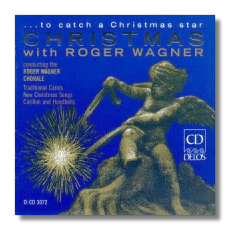
The Internet's Premier Classical Music Source
Related Links
- Latest Reviews
- More Reviews
-
By Composer
-
Collections
DVD & Blu-ray
Books
Concert Reviews
Articles/Interviews
Software
Audio
Search Amazon
Recommended Links
Site News
 CD Review
CD Review
… To Catch a Christmas Star

Christmas with Roger Wagner
- Carol arrangements by Rutter, Wagner, Gardner, Willcocks, Sowerby, Terri, Vaughan Williams, and others and works by Britten and Berlioz
Roger Wagner Chorale/Roger Wagner
Delos 3072 63:25
Summary for the Busy Executive: Wonderful.
In the Fifties and Sixties, one could argue that the two best professional U.S. choirs were the Robert Shaw and the Roger Wagner Chorales. Both groups disappeared somewhere in the late Sixties. Shaw went on to the music directorship of the Atlanta Symphony, while Wagner seemed to have dropped off the national choral map until his old age, when he began recording again. RCA kept at least some of Shaw's old recordings available, while Capitol/EMI forgot Wagner's work entirely.
The musical personalities of both men contrasted strongly, and they dominated choral practice in different regions of the country: Shaw mainly in the East and Wagner on the West Coast. Although both conductors used some of the finest professionals available (Florence Kopleff sang for Shaw while Marilyn Horne sang for Wagner), their groups sounded different and absolutely individual. Shaw favored what I'd call a clean, "Congregationalist" style, while Wagner cultivated a sound more opulent, akin to what Stokowski did for his orchestras. In both cases, this came about from tinkering: Shaw by a precise mix of individual singers, Wagner by transferring whole sections (contraltos not uncommonly mixed with tenors) or adding a discreet cello or organ pedal to the bass line. Both groups sang very much in tune, but unlike, say, certain more modern groups, intonation never excited you by itself. Shaw kept more to standard rep than Wagner, although this may have been due to their labels' programming strategies rather than to the musical preferences of the conductors themselves. Shaw was sharper rhythmically and more elegant, but Wagner often got more viscerally exciting performances. Fortunately, one didn't have to choose between them. We were extremely lucky to have both. I hope for more re-issues.
This may very well have been Roger Wagner's last recording, and it's a winner. If anything, the Chorale sounds even better than in the old days, and one can't, with certain exceptions, beat the program for attractiveness. Although Christmas has no religious meaning for me, its aesthetics have always attracted me. The symbols of birth in winter, the guiding heavens, the warmth at the center of the cold loneliness and clarity powerfully work upon me. It doesn't hurt that the carol tunes are among the most beautiful I know. Consequently, I favor arrangements which don't get in the way of the melodies. A few of the cuts succumb to the sentimental and the church-genteel, but in many cases, the caliber of performance removes most of the treacle. I wish only that Wagner had included more a cappella material. Highlights for me include "Sweet Little Jesus Boy" arranged by Wagner, "Tomorrow shall be my dancing day" arranged by John Gardner, Vaughan Williams' vigorous and suave "Wassail Song," and "Sing we now of Christmas," a bransle arranged by Prentice.
Salli Terri, a wonderful singer and arranger, contributes two stunning arrangements: "The Coventry Carol" and "O Come, O Come, Emmanuel." Because I can't help myself, I find myself comparing them to Alice Parker's classic settings for Shaw. Parker's setting are starker, more monumental, more dependent on modes, open fifths, and contrapuntal imitation. Terri's are warmer, closer to an idea of the folk's actual music-making.
Of the original compositions, Britten's "Hymn to the Virgin" and Berlioz's "L'Adieu des bergers à la Sainte Famille" stand out easily. Britten wrote the "Hymn" early on for choir and distant solo quartet. It poses challenges of intonation, dynamics, and seamless trade-offs between the two groups, which Wagner's singers meet and overcome (even if they do get help from an instrument-reinforced bass line). The Berlioz was a favorite of both Wagner and Shaw (the latter recorded it at least three times and featured it in his annual Cleveland Christmas concerts). Here, their usual musical personalities reversed. Shaw's reading aimed at and hit the sumptuous. Wagner's, telling in its simplicity, I think stands closer to Berlioz's concept. The rest of the program receives top-notch readings of exceptional flexibility and clarity. For example, he Vaughan Williams, conceived for a madrigal group, loses none of its grace or high spirits with Wagner's larger forces. Delos's sound is quite fine.
Copyright © 2000, Steve Schwartz


















